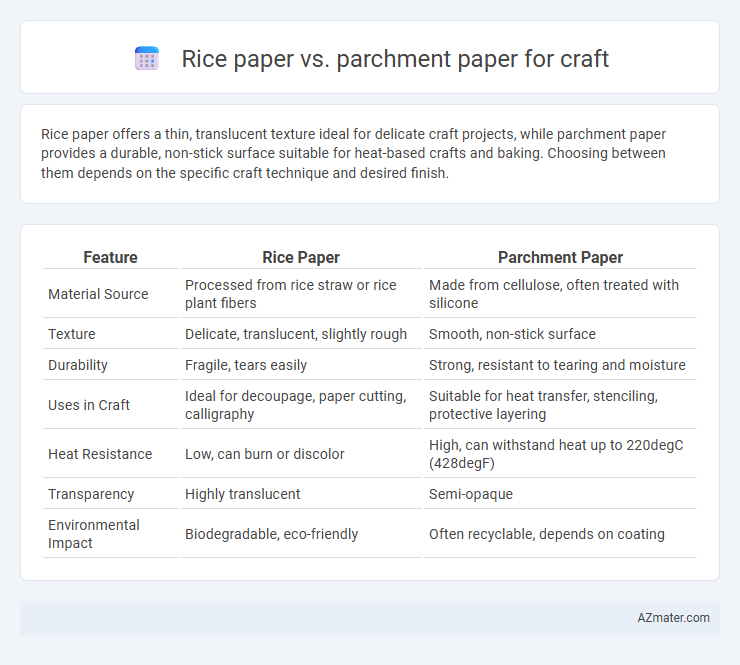Rice paper offers a thin, translucent texture ideal for delicate craft projects, while parchment paper provides a durable, non-stick surface suitable for heat-based crafts and baking. Choosing between them depends on the specific craft technique and desired finish.
Table of Comparison
| Feature | Rice Paper | Parchment Paper |
|---|---|---|
| Material Source | Processed from rice straw or rice plant fibers | Made from cellulose, often treated with silicone |
| Texture | Delicate, translucent, slightly rough | Smooth, non-stick surface |
| Durability | Fragile, tears easily | Strong, resistant to tearing and moisture |
| Uses in Craft | Ideal for decoupage, paper cutting, calligraphy | Suitable for heat transfer, stenciling, protective layering |
| Heat Resistance | Low, can burn or discolor | High, can withstand heat up to 220degC (428degF) |
| Transparency | Highly translucent | Semi-opaque |
| Environmental Impact | Biodegradable, eco-friendly | Often recyclable, depends on coating |
Understanding Rice Paper and Parchment Paper: Key Differences
Rice paper, derived from thin layers of rice starch, offers a delicate and semi-transparent texture ideal for intricate crafts like decoupage, calligraphy, and paper art. Parchment paper, made from cellulose fibers treated with an acid bath, provides a durable, non-stick, and heat-resistant surface commonly used in baking and craft projects requiring heat exposure. The key differences lie in their material composition, texture, and heat resistance, impacting their suitability for various artistic and practical applications.
Composition and Material Properties
Rice paper is made from natural fibers such as mulberry, hemp, or rice straw, offering a delicate, thin texture with slight translucency ideal for intricate craft projects. Parchment paper is typically crafted from cellulose fibers treated with silicone, granting it heat resistance, durability, and a non-stick surface suitable for activities requiring sturdier material. The porous and absorbent nature of rice paper contrasts with the smooth, waterproof finish of parchment paper, influencing their respective uses in decorative applications and heat-based crafting techniques.
Popular Craft Uses for Rice Paper
Rice paper excels in decoupage, scrapbooking, and card making due to its delicate texture and translucency that add an elegant, artistic effect to projects. Its lightweight and absorbent qualities make it ideal for layering and creating intricate, detailed designs, especially in mixed media art and paper crafts. Unlike parchment paper, which is primarily heat-resistant and used for baking, rice paper is prized for its aesthetic versatility and tactile appeal in popular craft applications.
Common Craft Applications of Parchment Paper
Parchment paper is widely used in crafting for its non-stick, heat-resistant properties, making it ideal for projects involving heat transfer, embossing, and stenciling. Its smooth surface allows for easy release of adhesives and paints, commonly applied in decoupage, candle making, and scrapbooking. Compared to rice paper, parchment paper offers greater durability and resistance to tearing during intricate craft work.
Texture and Appearance Comparison
Rice paper features a delicate, slightly translucent texture with a soft, natural fiber appearance ideal for detailed craft projects requiring a lightweight feel. Parchment paper offers a smooth, semi-glossy surface with a sturdier, more uniform texture suited for precise cutting and durability in crafting. The visual difference lies in rice paper's subtle fiber patterns versus parchment paper's clean, consistent finish, influencing project aesthetics and tactile experience.
Handling and Ease of Use in Craft Projects
Rice paper offers exceptional thinness and flexibility, making it ideal for delicate craft projects that require precise handling and intricate folding. Parchment paper is more durable and resistant to tearing, providing ease of use for painting, stamping, or projects needing a sturdy, non-stick surface. Rice paper requires careful handling due to its fragility, while parchment paper simplifies crafting with its resilience and smooth texture.
Compatibility with Various Art Mediums
Rice paper offers excellent compatibility with various art mediums such as ink, watercolor, and calligraphy due to its absorbent and lightweight texture, making it ideal for detailed brushwork and layering. Parchment paper, with its smooth and non-porous surface, works well for dry mediums like pencil, charcoal, and pastel but can resist wet mediums, preventing smudging and bleeding. Artists often choose rice paper for fluid applications requiring pigment absorption, whereas parchment paper excels in preserving sharp lines and clean strokes with minimal bleeding.
Durability and Longevity in Finished Crafts
Rice paper offers delicate texture but lower durability, making it ideal for light craft projects that prioritize aesthetics over strength. Parchment paper provides superior longevity and resilience, resisting tearing and moisture, which ensures finished crafts maintain integrity over time. For lasting durability in crafted items, parchment paper is the preferred choice due to its sturdier composition and resistance to environmental factors.
Environmental Impact and Sustainability
Rice paper, made from natural plant fibers like rice straw and bamboo, is biodegradable and compostable, offering a lower environmental footprint compared to traditional parchment paper often produced with chemical treatments and non-renewable resources. Parchment paper, especially if bleached or coated with silicone, can be less eco-friendly due to its processing and reduced recyclability, whereas untreated rice paper decomposes more readily without releasing harmful substances. Choosing rice paper for crafts supports sustainability goals by reducing waste and promoting use of renewable materials in eco-conscious artistic projects.
Choosing the Right Paper for Your Craft Needs
Rice paper offers a delicate, translucent texture ideal for intricate designs and traditional Asian art, while parchment paper provides a sturdier, non-stick surface suited for baking and heat-resistant crafts. Opt for rice paper when working on detailed calligraphy, decoupage, or scrapbooking projects requiring a lightweight, absorbent material. Choose parchment paper for projects involving heat application, such as candle making or baking crafts, where durability and resistance to grease and moisture are essential.

Infographic: Rice paper vs Parchment paper for Craft
 azmater.com
azmater.com